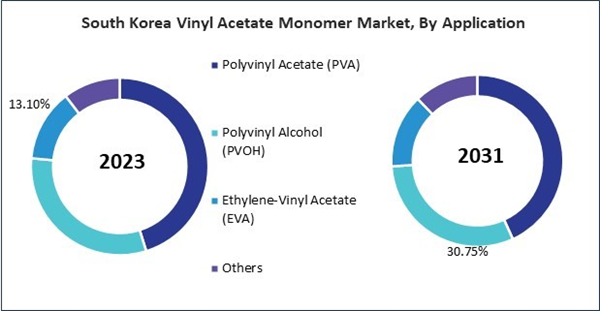Polyvinyl Acetate is a versatile polymer extensively utilized in various industries, including adhesives, coatings, textiles, and construction. In adhesives, PVA offers excellent bonding properties, water resistance, and flexibility, making it ideal for woodworking, packaging, and paper bonding applications. Thus, the South Korea market utilized 107.05 kilo tonnes of Polyvinyl Acetate in the market 2022.
The China market dominated the Asia Pacific Vinyl Acetate Monomer Market by Country in 2023, and would continue to be a dominant market till 2031; thereby, achieving a market value of $1,656.6 Million by 2031. The Japan market is showcasing a CAGR of 4.1% during (2024 - 2031). Additionally, The India market would register a CAGR of 5.4% during (2024 - 2031).
Vinyl acetate monomer (VAM) is a colorless liquid with a pungent odor, and it is produced through the reaction of acetylene and acetic acid. VAM is a versatile chemical intermediate building block for synthesizing polymers, resins, and other specialty chemicals.
Moreover, vinyl acetate monomer (VAM) is used in various industries and sectors owing to its versatile properties and compatibility with different materials. For example, VAM is a primary raw material for producing polyvinyl acetate (PVA) and copolymers like ethylene-vinyl acetate (EVA), which are widely used in adhesives and sealants.
The expansion of the chemical industry in India leads to increased demand for raw materials and intermediates, including VAM. As the chemical sector grows, there is a higher requirement for VAM in various applications such as adhesives, coatings, textiles, and packaging materials. The growth of the chemical industry in India opens up new market opportunities for VAM manufacturers and suppliers.
Based on End-user, the market is segmented into Construction, Packaging, Textile, Cosmetics, and Others. Based on Application, the market is segmented into Polyvinyl Acetate (PVA), Polyvinyl Alcohol (PVOH), Ethylene-Vinyl Acetate (EVA), and Others. Based on countries, the market is segmented into China, Japan, India, South Korea, Singapore, Malaysia, and Rest of Asia Pacific.
List of Key Companies Profiled
- Celanese Corporation
- LyondellBasell Industries Holdings B.V.
- The Dow Chemical Company
- DuPont de Nemours, Inc.
- Wacker Chemie AG
- Kuraray Europe GmbH (Kuraray Co., Ltd.)
- INEOS Group Holdings S.A
- Sinopec Group (China Petrochemical Corporation)
- Sipchem Company
- Exxon Mobil Corporation
Market Report Segmentation
By End-user (Volume, Kilo Tonnes, USD Billion, 2020-2031)- Construction
- Packaging
- Textile
- Cosmetics
- Others
- Polyvinyl Acetate (PVA)
- Polyvinyl Alcohol (PVOH)
- Ethylene-Vinyl Acetate (EVA)
- Others
- China
- Japan
- India
- South Korea
- Singapore
- Malaysia
- Rest of Asia Pacific
Table of Contents
Companies Mentioned
- Celanese Corporation
- LyondellBasell Industries Holdings B.V.
- The Dow Chemical Company
- DuPont de Nemours, Inc.
- Wacker Chemie AG
- Kuraray Europe GmbH (Kuraray Co., Ltd.)
- INEOS Group Holdings S.A
- Sinopec Group (China Petrochemical Corporation)
- Sipchem Company
- Exxon Mobil Corporation
Methodology

LOADING...









